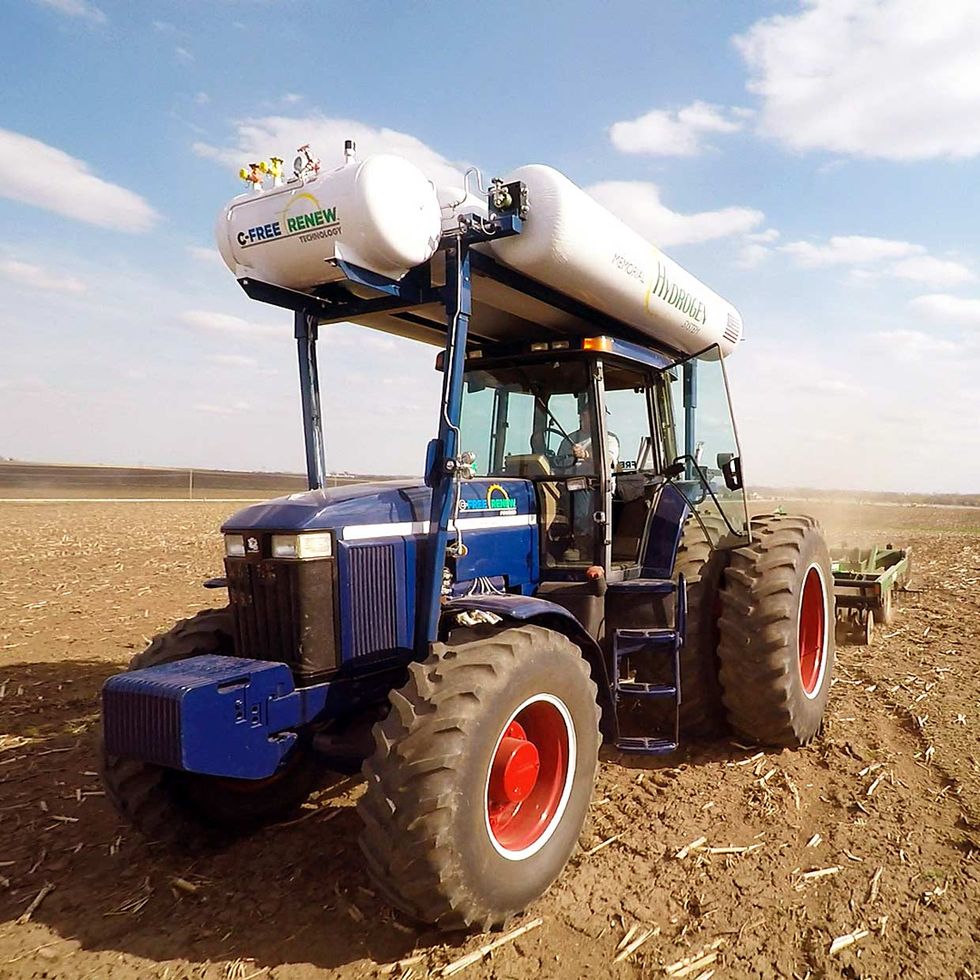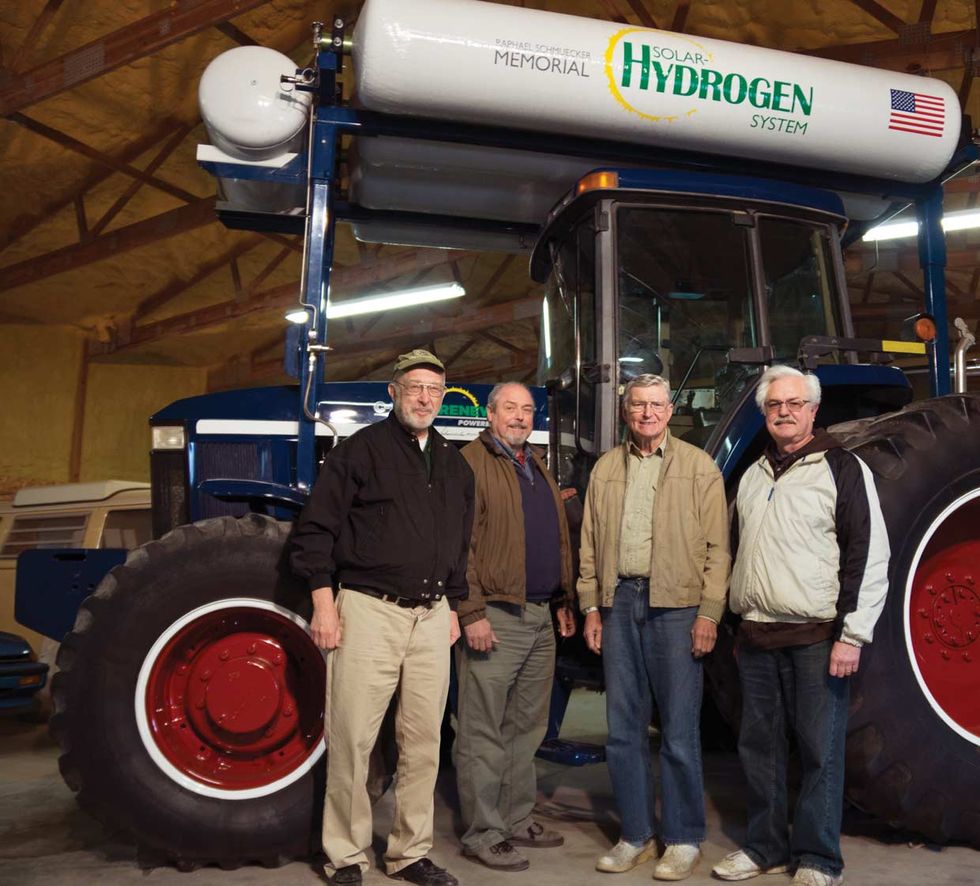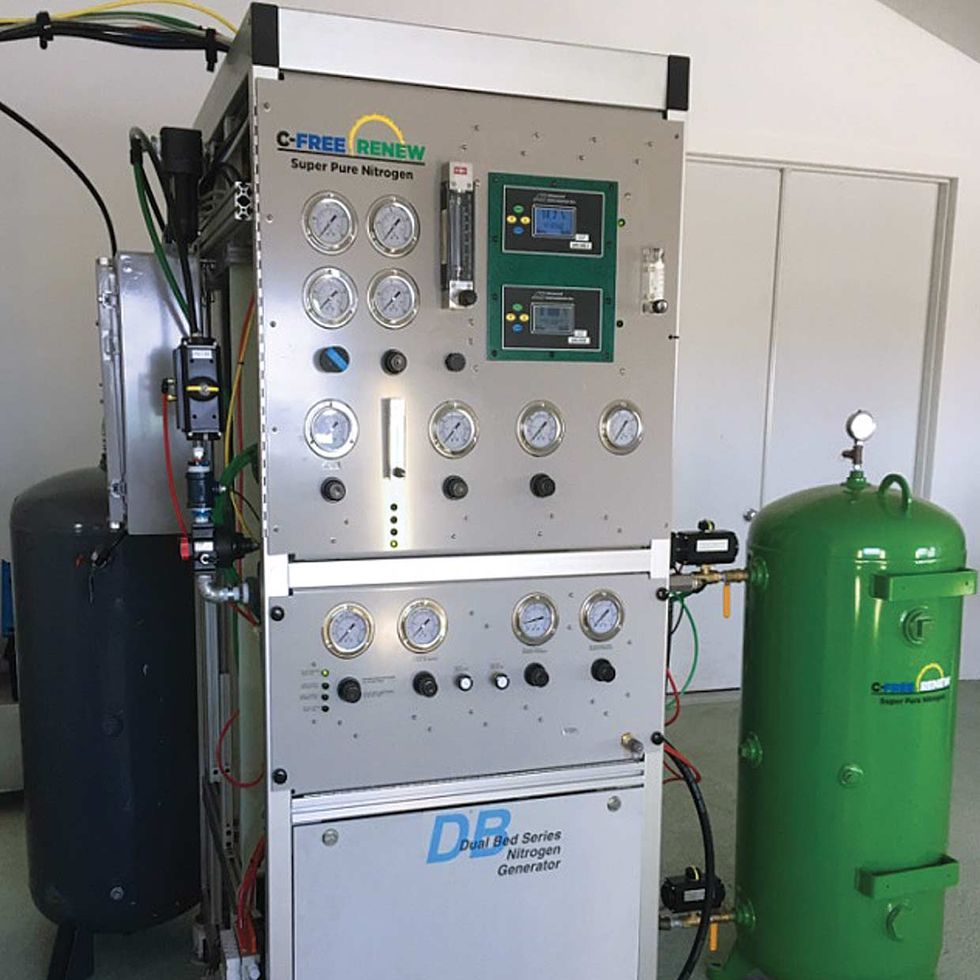A Retired JPL Engineer’s Journey: From Space Probes to Carbon-Neutral Farming
Jay Schmuecker’s Iowa farm uses solar power to generate fuel and fertilizer on-site
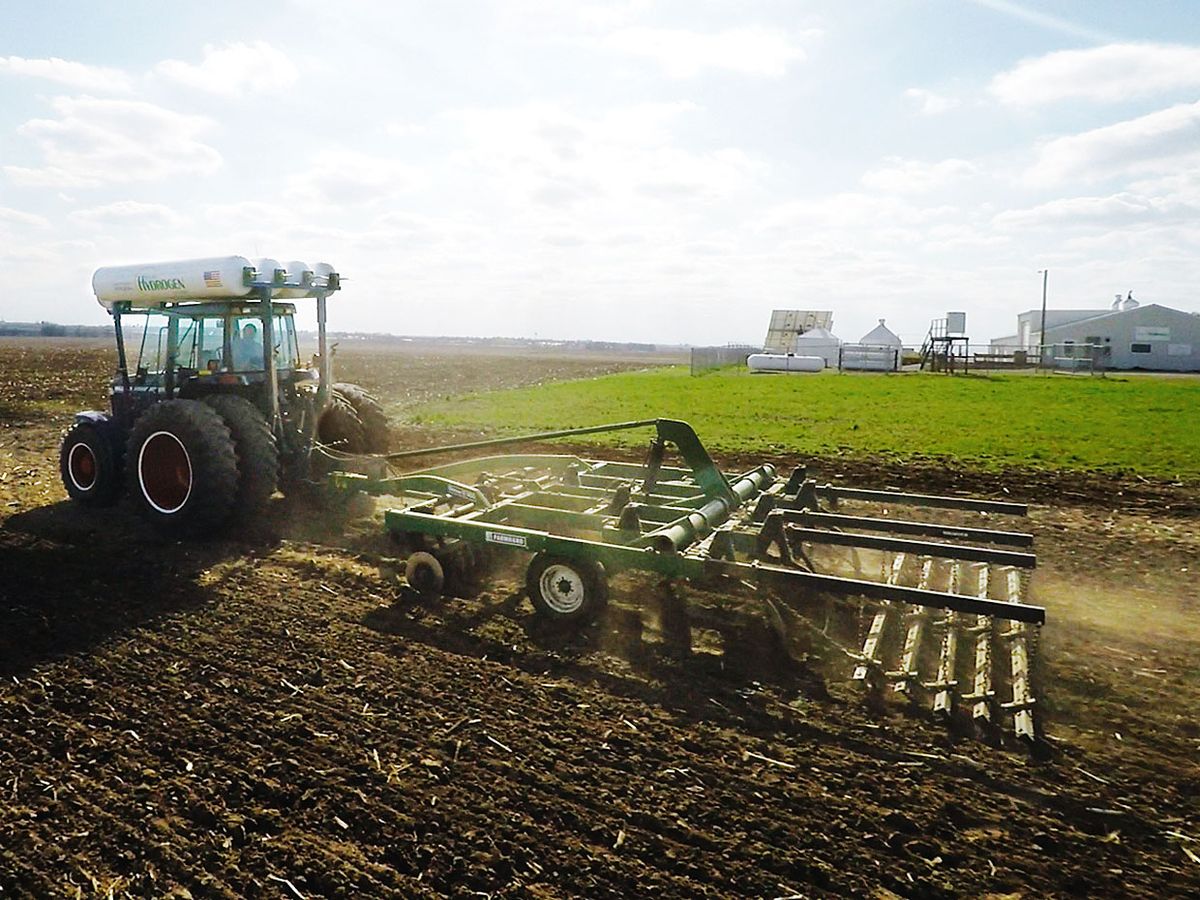
You could say that farming is in my blood: My grandparents on both sides ran large, prosperous farms in Iowa. One of my fondest childhood memories is of visiting my maternal grandparents’ farm and watching the intricate moving mechanisms of the threshing machine. I guess it’s not surprising that I eventually decided to study mechanical engineering at MIT. I never really considered a career in farming.
Shortly after I graduated in 1957 and took a job with the California Institute of Technology’s Jet Propulsion Lab, the Soviets launched Sputnik. I was at the right place at the right time. JPL was soon transferred to the newly formed NASA. And for more than 50 years, I worked with some of the brightest engineers in the world to send unmanned spacecraft—including Mariner, Viking, and Voyager—to all the other planets in the solar system.
But my love of farms and farming never went away, and in 1999, I purchased my paternal grandfather’s 130-hectare (320-acre) property, Pinehurst Farm, which had been out of the family for 55 years. I wasn’t exactly sure what I’d do with the place, but by the time I retired in 2007, there was more and more talk about climate change due to human-caused carbon emissions. I knew that agriculture has a large carbon footprint, and I wondered if there was a way to make farming more sustainable. After all, the most recent numbers are alarming: The World Meteorological Organization reports that the planet is on course for a rise in temperature of 3 to 5 °C by 2100. The U.S. Environmental Protection Agency estimates that agriculture and forestry accounted for almost 10 percent of greenhouse gas emissions in 2016. While a significant share of those are livestock emissions (that is, belches and flatulence), much of it comes from burning fuel to grow, harvest, and transport food, as well as fertilizer production.

I recalled a conversation I’d had with my dad and his friend, Roy McAlister, right after I acquired the farm. Roy was the president of the American Hydrogen Association, and he owned a hydrogen-powered Nissan pickup truck. Both men were vocal advocates for replacing fossil fuels with hydrogen to reduce the United States’ dependence on oil imports. The same transition would also have a big impact on carbon emissions.
And so, in 2008, I decided to create a solar-hydrogen system for Pinehurst Farm as a memorial to my father. I’d use solar power to run the equipment that would generate fuel for a hydrogen-burning tractor. Several years into the project, I decided to also make ammonia (nitrogen trihydride, or NH3) to use as tractor fuel and crop fertilizer.
My aim is to make the public—especially farmers—aware that we will need to develop such alternative fuels and fertilizers as fossil fuels become depleted and more expensive, and as climate change worsens. Developing local manufacturing processes to generate carbon-free fuel and fertilizer and powering those processes with renewable energy sources like solar and wind will eliminate farmers’ reliance on fossil fuels. And doing this all locally will remove much of the cost of transporting large amounts of fuel and fertilizers as well. At our demonstration project at Pinehurst, my colleague David Toyne, an engineer based in Tujunga, Calif., and I have shown that sustainable farming is possible. But much like designing spacecraft, the effort has taken a little longer and presented many more challenges than we initially expected.
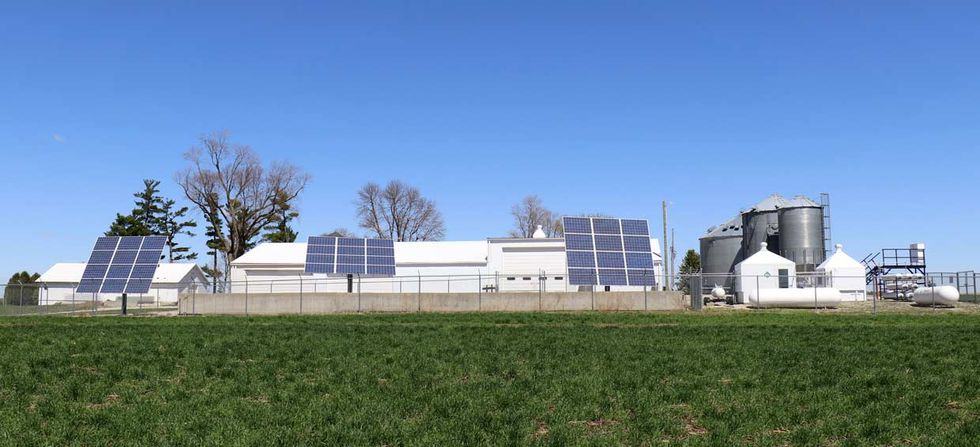
The system that we now have in place includes several main components: a retrofitted tractor that can use either hydrogen or ammonia as fuel; generators to create pure hydrogen and pure nitrogen, plus a reactor to combine the two into ammonia; tanks to store the various gases; and a grid-tied solar array to power the equipment. When I started, there were no other solar-hydrogen farms on which I could model my farm, so every aspect had to be painstakingly engineered from scratch, with plenty of revisions, mishaps, and discoveries along the way.
The work began in earnest in 2009. Before actually starting to build anything, I crunched the numbers to see what would be needed to pull off the project. I found that a 112-kilowatt (150-horsepower) tractor burns about 47 liters per hectare (5 gallons per acre) if you’re raising corn and about two-thirds that amount for soybeans. The same area would require 5 kilograms of hydrogen fuel. That meant we needed roughly 1,400 kg of hydrogen to fuel the tractor and other farm vehicles from planting to harvest. Dennis Crow, who farms the Pinehurst land, told me about half the fuel would go toward spring planting and half for fall harvesting. The growing season in Iowa is about 150 days, so we’d need to make about 4.5 kg of hydrogen per day to have 700 kg of hydrogen for the harvest. Spring planting would be easier—we would have 215 days of the year to make the remaining fuel.
To generate the hydrogen, we would split water into hydrogen and oxygen. By my calculations, running the hydrogen generator and related equipment would require about 80 kW of solar power. I decided to use two-axis solar arrays, which track the sun to boost the collection capacity by 30 percent. Based on the efficiency of commodity photovoltaic panels in 2008, we’d need 30 solar arrays, with each array holding 12 solar panels.
That’s a lot of solar panels to install, operate, and maintain, and a lot of hydrogen to generate and store. I soon realized I could not afford to build a complete operational system. Instead, I focused on creating a demonstration system at one-tenth scale, with three solar arrays instead of 30. While the tractor would be full size, we would make only 10 percent of the hydrogen needed to fuel it. I decided that even a limited demonstration would be a worthwhile proof of concept. Now we had to figure out how to make it happen, starting with the tractor.
As it turns out, I wasn’t the first to think of using hydrogen as a tractor fuel. Back in 1959, machinery manufacturer Allis-Chalmers demonstrated a tractor powered by hydrogen fuel cells. Fifty-two years later, New Holland Agriculture did the same. Unfortunately, neither company produced a commercial model. After some further research, I decided that fuel cells were (and still are) far too expensive. Instead, I would have to buy a regular diesel tractor and convert it to run on hydrogen.
Tom Hurd, an architect in Mason City, Iowa, who specializes in renewable-energy installations, assisted with the farm’s overall design. At his suggestion, I contacted the Hydrogen Engine Center in nearby Algona, Iowa. The company’s specialty was modifying internal combustion engines to burn hydrogen, natural gas, or propane. Ted Hollinger, the center’s president, agreed to provide a hydrogen-fueled engine for the tractor.
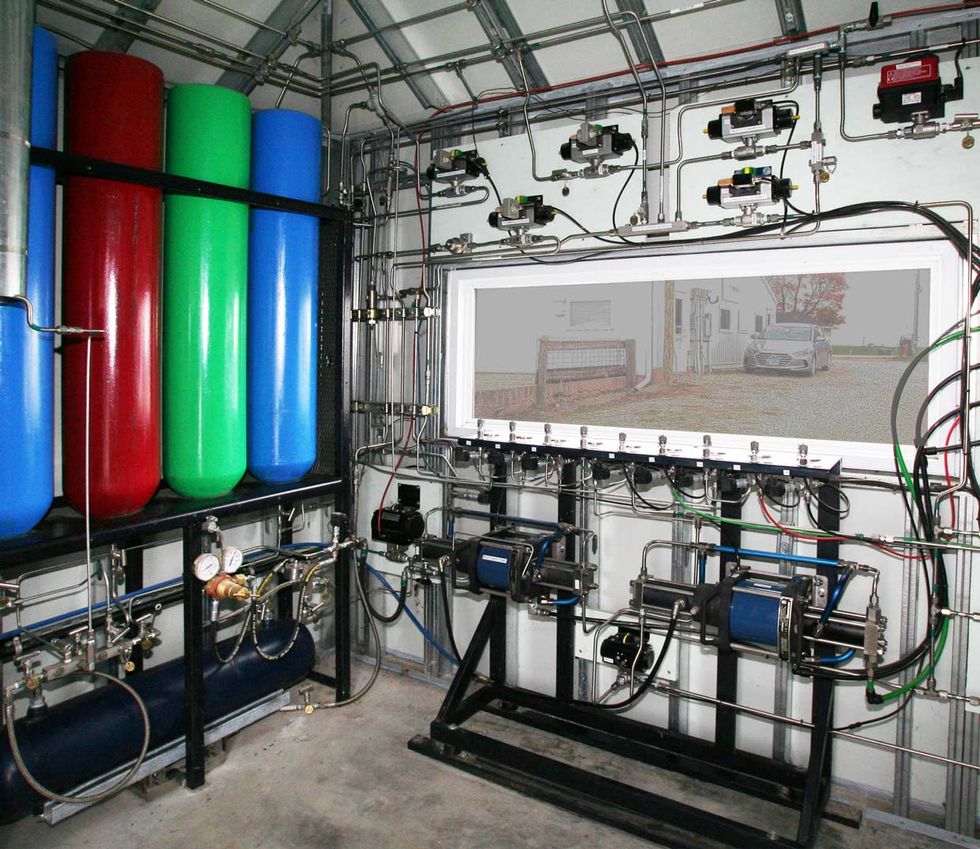
Hollinger’s design started with a gasoline-fueled Ford 460 V-8 engine block. He suggested that we include a small propane tank as backup in case the tractor ran out of hydrogen out in the field. Several months later, though, he recommended that we use ammonia instead of propane, to avoid fossil fuels completely. Since the idea was to reduce the farm’s carbon footprint, I liked the ammonia idea.
Scott McMains, who looks after the old cars that I store on the farm, located a used 7810 John Deere tractor as well as a Ford 460 engine. The work of installing the Ford engine into the tractor was done by Russ Hughes, who lives in Monticello, Iowa, and was already restoring my 1947 Buick Roadmaster sedan.
The tractor would need to carry several large, heavy fuel tanks for the hydrogen and ammonia. Bob Bamford, a retired JPL structural-design analyst, took a look at my plans for the fuel tanks’ support structure and redesigned it. In my original design, the support structure was bolted together, but Bamford’s design used welds for increased strength. I had the new and improved design fabricated in California.
The completed tractor was delivered to the farm in late 2014. With the flick of a switch in the cab, our tractor can toggle between burning pure hydrogen and burning a mixture of hydrogen and ammonia gas. Pure ammonia won’t burn in an internal combustion engine; you first need to mix it with about 10 percent hydrogen. The energy content of a gallon of ammonia is about 35 percent that of diesel. The fuel is then mixed with the intake air and injected into the tractor’s computer-controlled, spark-ignited engine cylinders. The tractor can run for 6 hours at full power before it needs to be refueled.
While work on the tractor proceeded, we were also figuring out how to generate the hydrogen and ammonia it would burn.
Ramsey Creek Woodworks of Kalona, Iowa, modified the farm’s old hog shed to house the hydrogen generators, control equipment, and the tractor itself. The company also installed the solar trackers and the solar arrays.
We constructed a smaller building to house the pumps that would compress the hydrogen for high-pressure storage. Hydrogen is of course incredibly flammable. For safety, I designed low slots in the walls on two sides so that air could enter and vent out the top, taking with it any leaked hydrogen.
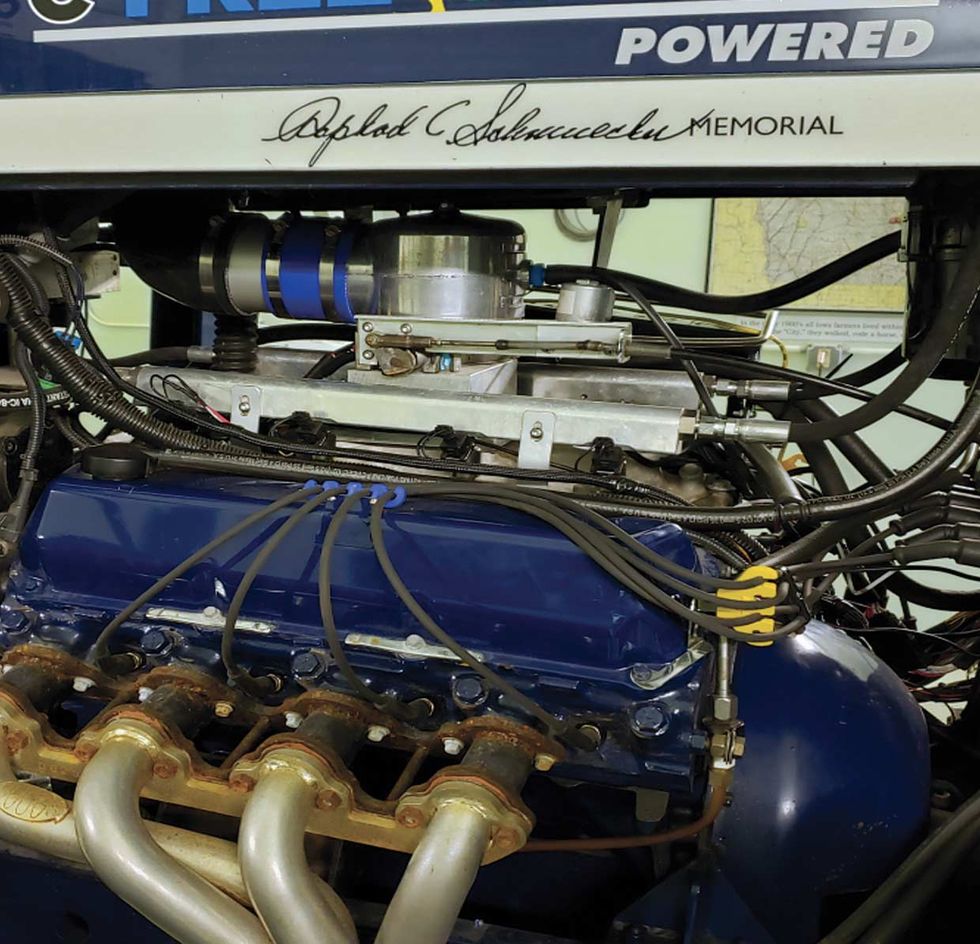
So how does the system actually produce hydrogen? The generator I purchased, from a Connecticut company called Proton OnSite, creates hydrogen and oxygen by splitting water that we pipe in from an on-site well. It is rated to make 90 grams (3 ounces) of hydrogen per hour. With the amount of sunlight Iowa receives, I can make an average of 450 grams of hydrogen per day. We can make more on a summer day, when we have more daylight, than we can in winter.
The generator was designed to operate continuously. But we’d be relying on solar power, which is intermittent, so David Toyne, who specializes in factory automation and customized systems, worked with Proton to modify it. Now the generator makes less hydrogen on overcast days and enters standby when the solar arrays’ output is too low. At the end of each day, the generator automatically turns off after being on standby for 20 minutes.
Generating ammonia posed some other challenges. I wanted to make the ammonia on-site, so that I could show it was possible for a farm to produce its fuel and fertilizer with no carbon emissions.
A substantial percentage of the world’s population depends on food grown using nitrogen-based fertilizers, including ammonia. It’s hard to beat for boosting crop yields. For example, Adam Sylvester, Pinehurst’s farm manager, told me that if we did not use nitrogen-based fertilizers on our cornfields, the yield would be about 250 bushels per hectare (100 bushels per acre), instead of the 500 bushels we get now. Clearly, the advantages to producing ammonia on location extend beyond just fuel.
But ammonia production also accounts for about 1 percent of all greenhouse emissions, largely from the fossil fuels powering most reactors. And just like hydrogen, ammonia comes with safety concerns. Ammonia is an irritant to the eyes, respiratory tract, mucus membranes, and skin.
Even so, ammonia has been used for years in refrigeration as well as fertilizer. It’s also an attractive carbon-free fuel. A ruptured ammonia tank won’t explode or catch fire as a propane tank will, and the liquid is stored at a much lower pressure than is hydrogen gas (1 megapascal for ammonia versus 70 MPa for hydrogen).
While attending the NH3 Fuel Conference in Sacramento in 2013, I had dinner with Bill Ayres, a director for the NH3 Fuel Association, and we discussed my interest in making ammonia in a self-contained system. Ayres pointed me to Doug Carpenter, who had developed a way to make ammonia on a small scale—provided you already have the hydrogen. Which I did. Carpenter delivered the reactor in 2016, several months before his untimely passing.
We turned again to Ramsey Creek to construct the ammonia-generation building. The 9-square-meter building, similar in design to the hydrogen shed, houses the pumps, valves, controls, ammonia reactor, collector tanks, and 10 high-pressure storage tanks. We make nitrogen by flowing compressed air through a nitrogen generator and removing the atmospheric oxygen. Before entering the reactor, the hydrogen and nitrogen are compressed to 24 MPa (3,500 pounds per square inch).
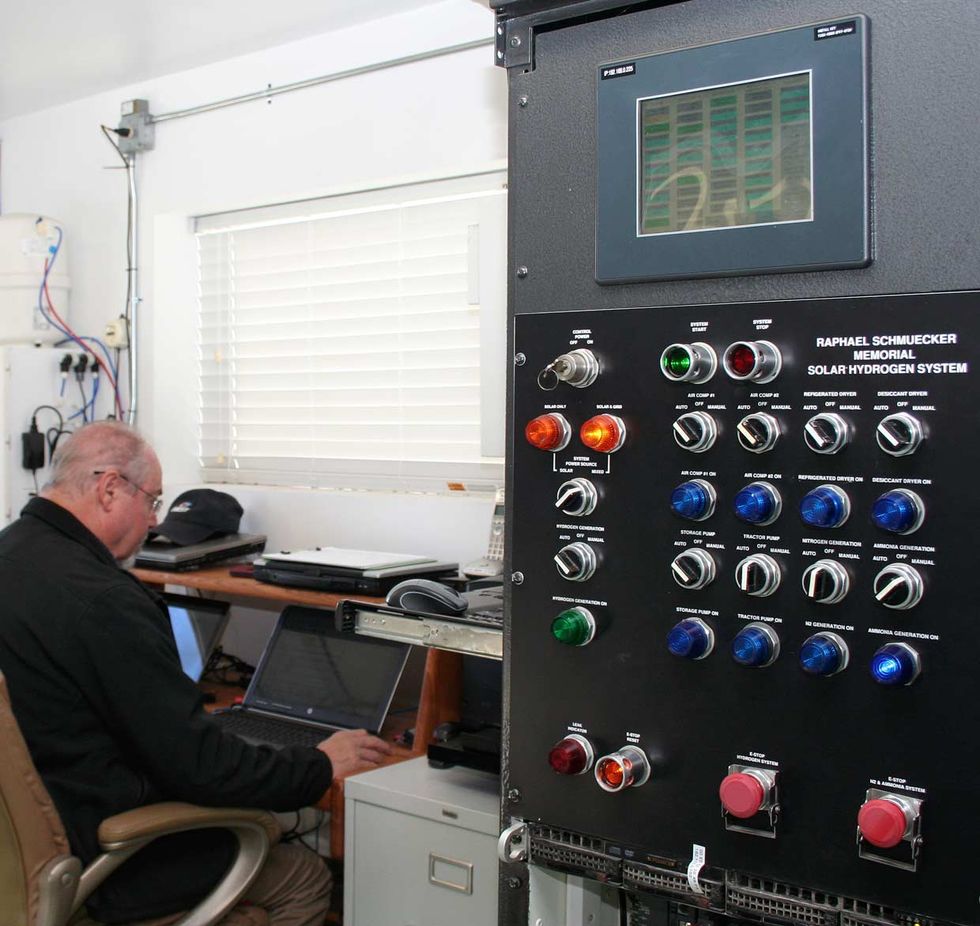
It’s been a process of trial and error to get the system right. When we first started making ammonia, we found it took too long for the reactor’s preheater to heat the hydrogen and nitrogen, so we added electrical band heaters around the outside of the unit. Unfortunately, the additional heat weakened the outer steel shell, and the next time we attempted to make ammonia, the outer shell split open. The mixed gases, which were under pressure at 24 MPa, caught fire. Toyne was in the equipment room at the time and noticed the pressure dropping. He made it out to the ammonia building in time to take pictures of the flames. After a few minutes, the gas had all vented through the top of the building. Luckily, only the reactor was damaged, and no one was hurt.
After that incident, we redesigned the ammonia reactor to add internal electrical heaters, which warm the apparatus before the gases are introduced. We also insulated the outer pressure shell from the heated inside components. Once started, the reaction forming the ammonia needs no additional heat.
Our ammonia system, like our hydrogen and nitrogen systems, is hooked up to the solar panels, so we cannot run it round the clock. Also, because of the limited amount of solar power we have, we can make either hydrogen or nitrogen on any given day. Once we have enough of both, we can produce a batch of ammonia. At first, we had difficulty producing nitrogen pure enough for ammonia production, but we solved that problem by mixing in a bit of hydrogen. The hydrogen bonds with the oxygen to create water vapor, which is far easier to remove than atmospheric oxygen.
We’ve estimated that our system uses a total of 14 kilowatt-hours to make a liter of ammonia, which contains 3.8 kWh of energy. This may seem inefficient, but it’s comparable to the amount of usable energy we could get from a diesel-powered tractor. About two-thirds of the electrical energy is used to make the hydrogen, one-quarter is used to make the nitrogen, and the remainder is for the ammonia.
Each batch of ammonia is about 38 liters (10 gallons). It takes 10 batches to make enough ammonia to fertilize 1.2 hectares of the farm’s nearly 61 hectares (3 of 150 acres) of corn. Thankfully, we can use the same ammonia for either application—it has to be liquid regardless of whether we’re using it for fertilizer or fuel.
We now have the basis of an on-site carbon-emission-free system for fueling a tractor and generating fertilizer, but there’s still plenty to improve. The solar arrays were sized to generate only hydrogen. We need additional solar panels or perhaps wind turbines to make more hydrogen, nitrogen, and ammonia. In order to make these improvements, we’ve created the Schmuecker Renewable Energy System, a nonprofit organization that accepts donations.
Toyne compares our system to the Wright brothers’ airplane: It is the initial demonstration of what is possible. Hydrogen and ammonia fuels will become more viable as the equipment costs decrease and more people gain experience working with them. I’ve spent more than US $2 million of my retirement savings on the effort. But much of the expense was due to the custom nature of the work: We estimate that to replicate the farm’s current setup would cost a third to half as much and would be more efficient with today’s improved equipment.
We’ve gotten a lot of interest about what we’ve installed so far. Our tractor has drawn attention from other farmers in Iowa. We’ve received inquiries from Europe, South Africa, Saudi Arabia, and Australia about making ammonia with no carbon emissions. In May 2018, we were showing our system to two employees of the U.S. Department of Energy, and they were so intrigued they invited us to present at an Advanced Research Projects Agency–Energy (ARPA-E) program on renewable, carbon-free energy generation that July.
Humankind needs to develop renewable, carbon-emission-free systems like the one we’ve demonstrated. If we do not harness other energy sources to address climate change and replace fossil fuels, future farmers will find it harder and harder to feed everyone. Our warming world will become one in which famine is an everyday occurrence.
This article appears in the November 2019 print issue as “The Carbon-Free Farm.”
About the Author
Jay Schmuecker worked for more than 50 years building planetary spacecraft at NASA’s Jet Propulsion Laboratory. Since retiring, he has been developing a solar-powered hydrogen fueling and fertilization system at Pinehurst Farm in eastern Iowa.
